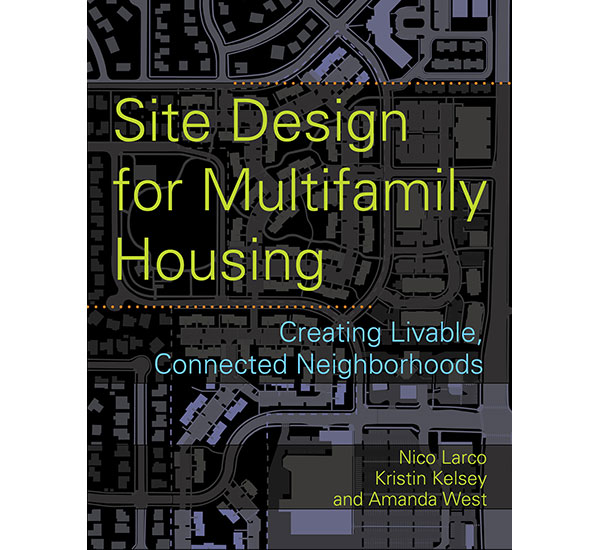
Authors: Nico Larco, Kristin Kelsey, and Amanda West (Island Press, 2014)
Given multi-unit residential housing accounts for the vast majority of the work done by the firm I work for, I was eager to peer inside Site Design for Multifamily Housing: Creating Livable, Connected Neighborhoods and see what types of insights I could glean. It is not a stretch to say that multi-unit housing is one of the runners at the forefront of sustainability talks, with everything hinging on walkability, proximity to transit, shopping, and the decreasing need for a car-based society. Multifamily housing creates small communities in their midst and, arguably, it is in these communities that our futures lie.
Broadly speaking, the book starts with more general information catered to the lay person and becomes increasingly more specific and technical as the book progresses, making it more relevant to practitioners.
It begins with a simple introduction, and moves into the criteria for good site design – containing sections that all can follow whether practitioner or layman. From there, the book moves into Project Profiles that highlight four developments (two in Oregon, one in California, and one in North Carolina), pointing out aspects that are working in these developments based on the previous criteria. Each study goes into some detail regarding to how solid precedents have been set by these developments.
The next section – Project Retrofit – looks at two more developments (one in Oregon, one in Arizona), getting a little more technical and focusing on specific elements of the criteria that are not met. This includes a wonderful series of manipulated images – renderings over the old photos – of how these new criteria could be facilitated through a few simple design decisions. This section was quite strong in its detailed explanations, and I enjoyed the graphical nature of content. It was easy to follow and understand, and agreed with many of the criteria outlined.
Any layperson would find in these first few sections a good, informative read – the analyses done, are factual, easy-to-follow, and make the design decisions look completely attainable, which is a strong element when dealing with these types of developments (the quick sell). That being said, expanding the limited number of case studies to include other global examples would have strengthened the content and added more variety to the projects presented.
At this point, the book seems to turn towards the practitioner. As the name states, the Project Checklist section outlines a list of criteria that allows developers and/or designers to follow along with their own projects in the hopes of achieving a strong site design. This was a nice touch and flowed well with the end of the book.
After this chapter, there was a breakdown of the building code language from the California, Oregon, and North Carolina developments, making it a little bit easier to understand, and use to ones benefit. For example, there is a topic header called “Continuity of Streets,” which would then have the following explanation: “The surrounding street network should help determine the look and placement of streets.” Beside this were items from different building codes that could help one achieve the aforementioned criteria. For “Alignment” of the roads, an excerpt is taken from the San Jose, CA building code stating, “Public streets should be aligned so that they are continuous through adjacent existing and planned residential development, creating a network of neighbourhood streets.” By doing this, the authors put the building code to work for you, finding ways where codes from the different states can answer some of the necessary criteria for proper site design.
While this section becomes a little more difficult to get through due to the nature of the content, it is still a very valuable resource. It is also important to note that the codes in America are different than those in Canada, so their applicability locally is somewhat limited.
The final section is an Appendix of unedited building code terminology, in its raw state. Again, this is greatly helpful for those entrenched in the field, but limiting for the layperson and may restrict the latter from finding their way through the entire book.
Given that I lean towards making books more accessible to larger audiences, I was left with a little paradox upon finishing the book. On one hand I wanted more information and depth about the developments that worked and a more robust sampling of the wonderful criteria that were laid out to see it working in several different contexts. I tend believe that giving broader responses to design criteria creates a far more achievable goal, as precedents are seen.
On the other hand, I personally could have done with less information with respect to the code appendix at the back of the book. This, of course, might not be the case for practitioners who work in the United States and want specific code references to work from. When things move into minute details, I find that the targets can become too specific and stop people from accessing the relevant information.
On the whole, however, I think Site Design for Multifamily Housing was a strong book with very good information from which both laypeople and practitioners can learn. At the end of the day, adding more examples from around the globe and testing them against the criteria put forth can only strengthen it and one hopes that there will be another edition that expands the solid foundation presented.
***
For more information on , visit the Island Press website.
**
Jeremy Senko is happily lost in the world of theoretical architecture and design. He is forever a student at heart, consistently reading, experiencing and learning about the world he inhabits. More specifically, he recently completed his Bachelor of Interior Design at Kwantlen Polytechnic University, where he pushed the limits (and the patience) of his professors.




